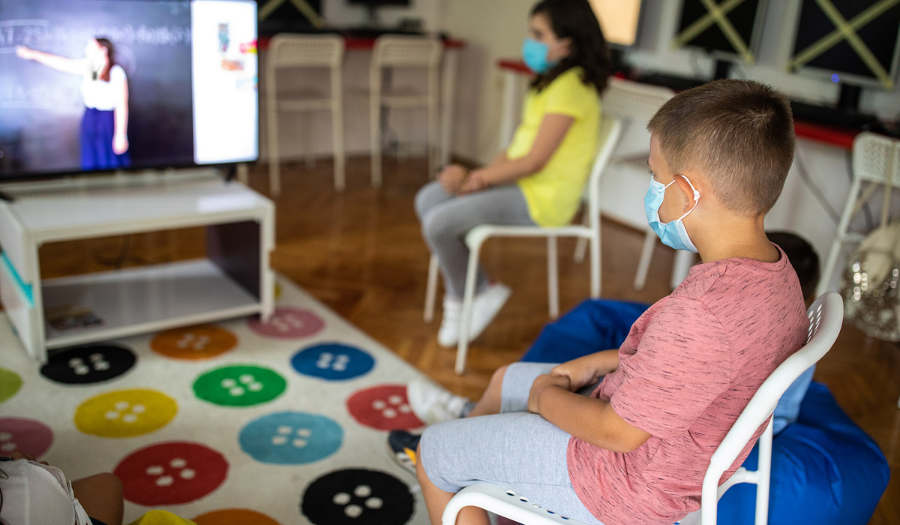Whether “roomers or Zoomers,” Lightspeed offers “crystal clear sound”

Fourth grade special education teacher Jaimee Rothenberg says the Lightspeed classroom instructional audio system was an important tool before the COVID-19 pandemic, helping students with auditory issues who may have otherwise needed preferential seating, and helping all students hear lessons more clearly.Now, managing a hybrid classroom with both virtual and remote students, “it has been everything and more.”
“I truly couldn’t imagine going through this without it,” said Rothenberg, a teacher at Salt Brook Elementary School in New Providence, New Jersey.
Rothenberg and her colleagues recently shared their experiences implementing Lightspeed instructional audio systems in the webcast series In Action: Instructional Audio in the Classroom during COVID and Beyond.
Salt Creek Elementary first started using Lightspeed’s classroom audio system eight years ago, funding using a grant directed at serving special education needs from the New Providence Education Foundation. But after learning more about the benefits for all students at a principal roundtable event, administrators began seeking additional grants through the foundation and the school’s parent-teacher organization to install the system in every classroom.
Health measures aimed at reducing risks of transmitting the novel coronavirus have forced schools to adjust to new hybrid formats that created new urgency to classroom audio systems, said Natasha Allen, who co-teaches with Rothenberg.
“Since we have students in the classroom and at home, we really need to be able to make sure that all students are able to hear us,” Allen said. “With the audio system, they really are able to hear everything we’re teaching, whether they’re in class that day or at home”
Rothenberg said the Lightspeed system was already an important classroom tool, adding “bringing it into the hybrid model has just sort of brought it to the next level.”
Optimizing hybrid instruction
As the school prepared to navigate an unprecedented academic year with hybrid classrooms and health measures such as masks and social distancing, a key concern was making sure all students could clearly hear their teachers and classmates.
As Julie Spoerl, a technology specialist for Salt Creek Elementary, began experimenting with technology models, she quickly recognized the important role the Lightspeed systems in delivering audio equitably.
“These have been a lifesaver this year,” she said.
Spoerl said they made some adjustments to their audio system setup as they planned for hybrid instruction to address the complexity of having students both in the classroom and learning remotely. Instead of locating the speaker opposite the teacher – usually the back of the room – they’ve moved it next to the desktop computer, enabling the audio to project to students learning over the video platform service.
With students learning remotely, the speaker “needs to be wherever the audio source for Zoom is going to be,” Spoerl said.
At Salt Creek, teachers use a combination of projectors and sharable boards to enable students learning remotely to fully participate. If a teacher moves to a different part of the room not captured by the classroom camera, they use an iPad as a mobile camera so students can see need resources, such as bulletin boards or whiteboards.
“When they do that the sound of their voice is not interrupted because the microphone is always on them and always going through the sound of the Zoom,” Spoerl said.
“Crystal clear sound that fills the room”
Allen said using Lightspeed’s system enhances the students’ learning experience, no matter where they are in the classroom or even if they are learning remotely.
“It really just provides crystal clear sound that just fills the room,” she said. “It doesn’t matter where you are in relation to where I’m standing.”
Facilitating student needs, engagement
By distributing clear audio throughout the room, the Lightspeed system has made it easier for Salt Creek Elementary to accommodate students with auditory learning challenges who may need preferential seating, Rothenberg said.
“A lot of students have preferential seating in their IEPs, but we’re not always in the front of the room,” she said, adding that with the classroom audio system, “all students can hear us equitably.”
Allen said the wireless mics also support engagement, helping students practice public speaking skills.
“They love to use the microphone,” she said.
Seamless audio for co-teachers
Allen co-teaches fourth grade with special education teacher Jaimee Rotenberg, and Lightspeed’s wireless mics allow them to instruct seamlessly, building off each other from around the classroom. The teaching partners use different channels on their wireless mics to enable students to hear them clearly no matter where they are.
“I’m easily able to chime in and help and re-direct and without the emic, that would have never been able to happen,” Rothenberg said. “It doesn’t matter who’s in front of the room; both of us can help all of the students equitably whether they’re in front of us or at home. I couldn’t imagine being a co-teacher without it.”
Easing vocal strain, simple to learn
Allen said the Lightspeed system helps ease the physical toll of constantly projecting her voice as she teaches.
“We speak for hours and hours a day and we can really strain our vocal cords,” she said. “This mic really allows me to not have a sore throat as much as I used to because I don’t have to speak at a higher level.”
Allen and Rothenberg encourage other teachers to try the classroom audio system, which is easy to learn.
“This is something new you can learn in 5 seconds,” Allen said. “Don’t be afraid to try it.”
Spoerl, who added the biggest adjustment is knowing when to turn the wearable mic on and off, encourages teachers to ask for help setting up the classroom system and making any needed adjustments.
“Keep the battery charged, that’s the best tip,” she said.
